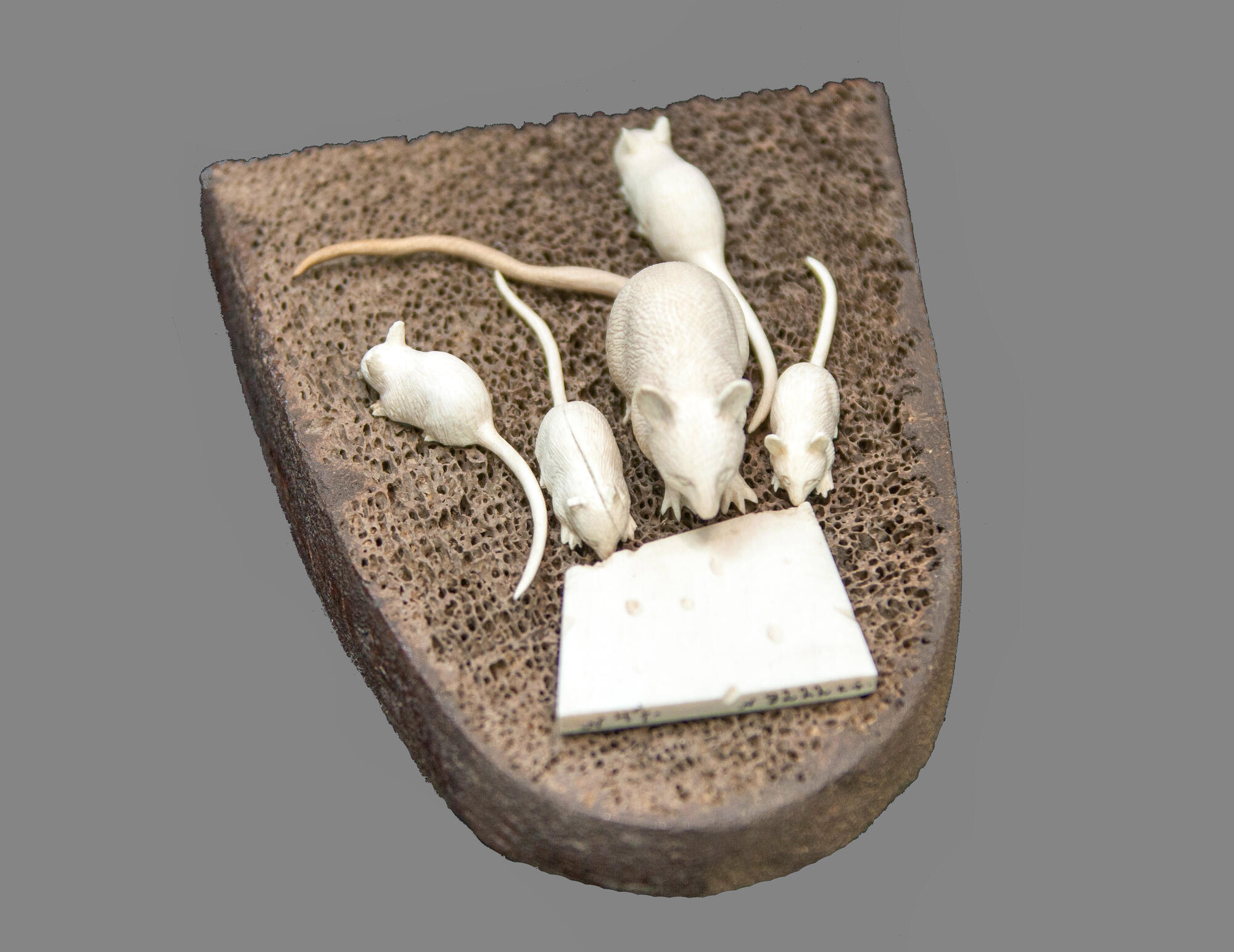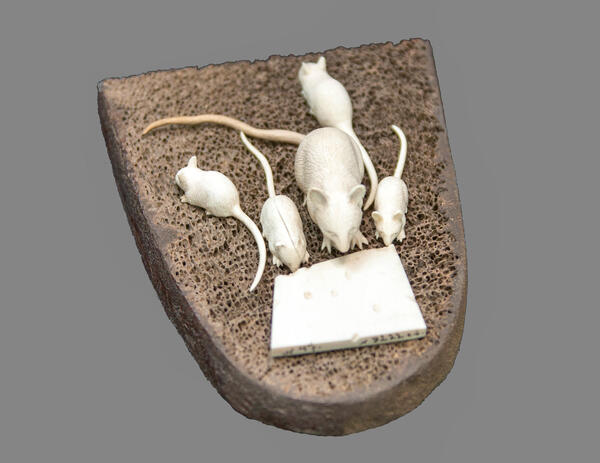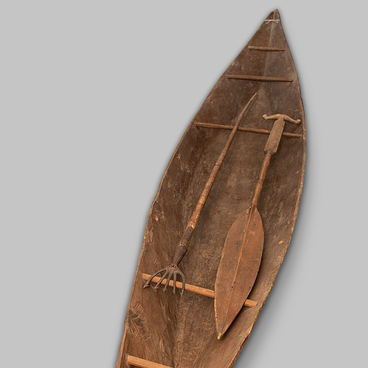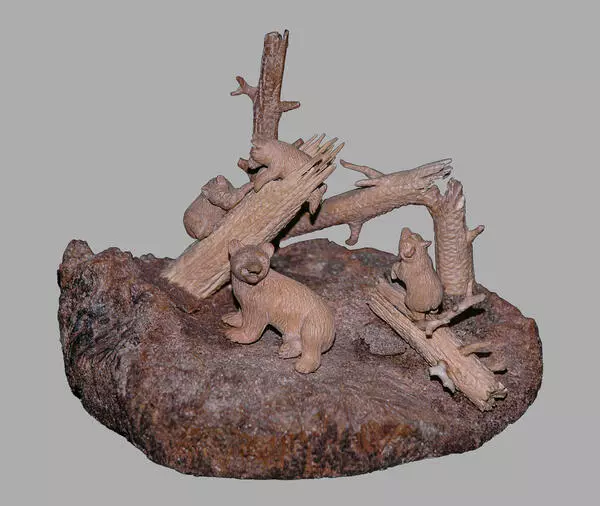The sculptural composition ‘A mouse with four young mousekins on a bread slice’ by the artist Porfiriy Terentyev was received by the Tobolsk Museum in 1928 from the discontinued Tobolsk Museum of Fine Arts. It is believed that Terentyev had laid the foundation for miniature genre sculpture in the bone-cutting art in Tobolsk.
For creating this sculpture the master used three-dimensional carving on a mammoth tusk. On a stand imitating a piece of rye bread, Terentyev placed a piece of cheese carved from a bone, and in front of it — a whole mouse family, a mother and four little mice. In this sculptural composition, the artist demonstrated how the white mammoth bone and brown bone, which many considered unsuitable, can be combined.
Porfiriy Terentyev was a peasant coming from the village of Samarskoe, Tobolsk Uezd. His father was born in Siberia, and his mother came from Ukraine. When he was a child, Porfiriy was interested in wood carving and once he made a wooden figure of the police officer DzerzhInsky. After the police officer saw this figure, he sent the boy to Tobolsk to become an apprentice to Mikhail Znamensky, a bone-cutter.
Unfortunately, Terentyev could not continue learning the art of bone-cutting due to family circumstances, and he had to return to the village and do the routine peasant work. He spent the years of his military service in Beryozov. In his spare time, Terentyev carved sculptural portraits of Ostyaks from wood, and when he returned to Tobolsk, he began to use mammoth bone as carving material. The master’s only tool was a simple penknife. In 1900, Terentyev’s sculptures, carved from bone, were highly appreciated at the Paris International Exhibition. Until 1913, Terentyev worked in almost all bone-cutting workshops, later he opened his own workshop, but it did not last long.
In 1916, Terentyev visited Petrograd, where he showed his works to the professor of the Academy of Arts, artist Ilya Repin. The art pieces created by the Tobolsk bone-cutter impressed academicians, and the magazine ‘World Panorama’ wrote about Terentyev: ‘Now in Petrograd we have a peasant named Porfiriy Grigoryevich Terentyev who came from the Tobolsk Governorate. He creates incredible animal figures carving them from mammoth tusks directly from life with amazing artistry and expression. His main tool for carving is a simple penknife. According to the professors from the Academy of Fine Arts who saw his art pieces, he is extremely talented.’ This article was published together with the photos of his works.
For creating this sculpture the master used three-dimensional carving on a mammoth tusk. On a stand imitating a piece of rye bread, Terentyev placed a piece of cheese carved from a bone, and in front of it — a whole mouse family, a mother and four little mice. In this sculptural composition, the artist demonstrated how the white mammoth bone and brown bone, which many considered unsuitable, can be combined.
Porfiriy Terentyev was a peasant coming from the village of Samarskoe, Tobolsk Uezd. His father was born in Siberia, and his mother came from Ukraine. When he was a child, Porfiriy was interested in wood carving and once he made a wooden figure of the police officer DzerzhInsky. After the police officer saw this figure, he sent the boy to Tobolsk to become an apprentice to Mikhail Znamensky, a bone-cutter.
Unfortunately, Terentyev could not continue learning the art of bone-cutting due to family circumstances, and he had to return to the village and do the routine peasant work. He spent the years of his military service in Beryozov. In his spare time, Terentyev carved sculptural portraits of Ostyaks from wood, and when he returned to Tobolsk, he began to use mammoth bone as carving material. The master’s only tool was a simple penknife. In 1900, Terentyev’s sculptures, carved from bone, were highly appreciated at the Paris International Exhibition. Until 1913, Terentyev worked in almost all bone-cutting workshops, later he opened his own workshop, but it did not last long.
In 1916, Terentyev visited Petrograd, where he showed his works to the professor of the Academy of Arts, artist Ilya Repin. The art pieces created by the Tobolsk bone-cutter impressed academicians, and the magazine ‘World Panorama’ wrote about Terentyev: ‘Now in Petrograd we have a peasant named Porfiriy Grigoryevich Terentyev who came from the Tobolsk Governorate. He creates incredible animal figures carving them from mammoth tusks directly from life with amazing artistry and expression. His main tool for carving is a simple penknife. According to the professors from the Academy of Fine Arts who saw his art pieces, he is extremely talented.’ This article was published together with the photos of his works.




